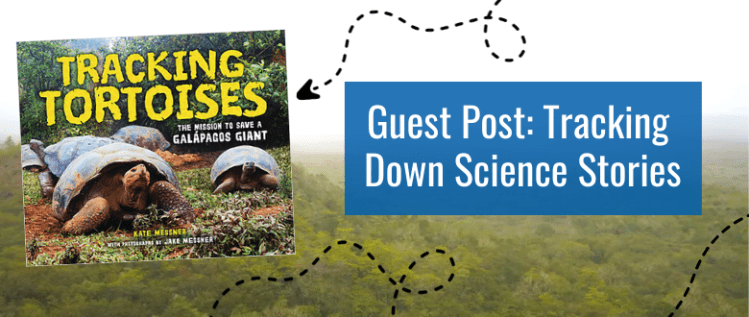Guest Post: Tracking Down Science Stories with Kate Messner

by Kate Messner, author of Tracking Tortoises: The Mission to Save a Galápagos Giant
Ask anyone who loves the natural world about places they’d love to visit, and chances are, the Galápagos Islands will be near the top of the list. Growing up in a small town in Western New York, I’d read about the unique wildlife endemic to the islands and the work scientists were doing there. It felt worlds away from the apple orchards and white-tailed deer of my own backyard, and I imagined how amazing it would be to visit one day, to see those amazing animals and learn more about the islands they call home.
Fast forward to January of 2019, when I read about the Giant Tortoise Movement Ecology Programme, an effort to track endangered giant tortoises in the Galápagos to learn more about their movements and migrations and, ultimately, to help with their conservation. I’d just wrapped up work on a work of middle grade nonfiction called Tracking Pythons, about researchers using radio telemetry to track Southwest Florida’s invasive Burmese pythons and wondered if these island scientists might be open to being the subjects of a follow-up title. I sent an email to project founder Stephen Blake, and after months of back and forth (and a lot of paperwork from the Galápagos National Park!), we’d made arrangements for an August visit to the islands. I couldn’t wait to spend time with this team of scientists who dedicated their lives to tracking tortoises.
We decided to make it a family trip and planned to spend a few extra days to explore the islands. My son Jake, a radio frequency engineer and photographer, agreed to be the field photographer for the project, and before we set out with the tortoise team, we spent a couple of days exploring, getting a feel for this place that so many unique animals call home.
The wildlife is Galápagos isn’t something you have to search for. Animals are everywhere, from the fish market where sea lions and pelicans sneak bites of the daily catch, to the beaches, where the rocks and sand teem with marine iguanas and Sally Lightfoot crabs.



We met up with Steve Blake and Freddy Cabrera early one morning and piled into Steve’s pickup truck for the drive up to the Santa Cruz highlands. It was garua season (garua means “mist” in Spanish), so the air was cool, and a drizzly rain fell from the grey sky.

On this day, we planned to track several tortoises that were already fitted with the team’s gps transmitters, so we set out over the volcanic rocks and through the thick vegetation, hiking the route the tortoises must walk on their stubby legs each year as they migrate.



Writing about scientists at work in the world involves a lot of observing, listening, and staying out of the way. My years as a journalist taught me that when you’re writing an authentic story, the best way to do that is to let the subjects do their work, as if you weren’t there. So Jake and I followed along, taking photographs and notes and asking the occasional question but mostly watching the way the team worked–how they followed the beeping of the radio receiver to locate tagged tortoises, and how they reacted when they found one, greeting them as if they were old friends. I listened and took notes and Steve and Freddy chatted with the hatching named Paolo as they measured and weighed him.

When I visit schools and libraries and talk about Tracking Tortoises with kids, they often ask, “Did you get to tag a tortoise?” And the answer is no. While I’m sure that would be a cool thing to do, it wasn’t my job to insert myself into the story–I’m not a tortoise researcher, and I was there to report on people who were.
Even so, I couldn’t help but be swept up in the awe of these incredible creatures. On our third day in the field with the tortoise team, we visited a local farm where tortoises share the land with coffee and papaya trees so the team could add a new tagged tortoise to their roster. It rained most of the morning, and Steve knew it would be difficult to attach a gps transmitter in that weather without the epoxy getting wet and running the risk that it might fall off, so we waited. Eventually, the rain slowed to a mist and the researchers headed out to find the male tortoise they planned to tag. Under umbrellas, they used epoxy to attach the transmitter, smoothing it over the edges so it would be less likely to catch on vegetation as the tortoise migrates.

We spent three days with the tortoise team in all, tagging along as they tracked and tagged tortoises in the field and completed related work in the lab. On the plane ride home, the field research was over, but the writing was just beginning. My first step in drafting a book like this is organizing my research. As the Galápagos Islands grew smaller out the plane window, I was transcribing my interviews and natural sound collected in the field and beginning to weave that field research in with all that I’d read in books and journals to prepare for the trip.
Many months–and many, many revisions later–Tracking Tortoises is the result. It was such a privilege to spend time with this devoted team of researchers and the amazing animals they’re trying to save, and it’s an honor to share their story with curious young readers.
Tracking Tortoises: The Mission to Save a Galápagos Giant
Interest Level: Grade 4 – Grade 8 · Reading Level: Grade 5
“Messner smoothly introduces her readers to the formation and population of this famous archipelago . . . Science at work in a unique setting.”—starred, Kirkus Reviews

Love hearing from authors and experts? Find more guest posts here!
Comments